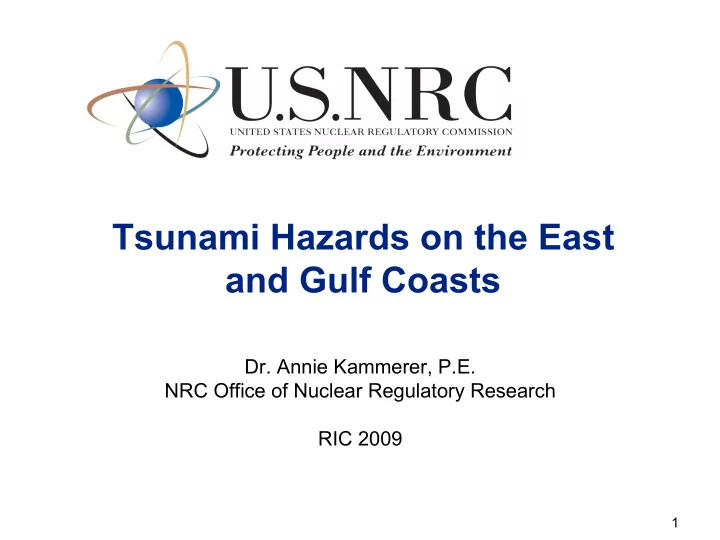

Tsunami Hazards on the East and Gulf Coasts Dr. Annie Kammerer, P.E. NRC Office of Nuclear Regulatory Research RIC 2009 1
Overview • Research Goals • Overview of program • Available products 2
Research Goals • Better understanding for all US coasts • Development of a source database • Integration of landslide modeling • Input for probable maximum tsunami (PMT) hazard levels • PTHA (probabilistic) where appropriate • Incorporation into regulatory guidance 3
NRC RESEARCH Pacific Coast East Hawaii Coast Gulf Coast 4
Damage comes from … • Wave inundation • Drawdown (important for plants) • Floating debris • Scour 5
Idealization of size-frequency relationship of tsunami sources 1 Distant Earthquakes 10 Recurrence Interval (yr) ≡ (annual probability of exceedence) -1 100 Local Earthquakes 1000 Volcanoes Landslides 10000 Asteroid Impact 1 10 100 1000 Size of Tsunami (m) Power et al., 2005 6
Sources Addressed • Near-field seismic • Far-field seismic • Near-field landslide • Far-field landslide • NOT: – Asteroid Impacts – Volcanic 7
Research Plan 1. Data collection, review of current state of knowledge, interpretation of data, basic modeling (completed - first USGS report) 2. Targeted field work, additional analyses, additional modeling (second USGS report) 3. Updating NOAA models for landslide sources, global modeling 4. Hazard map development 5. PTHA 8
Data collection, review of current state of knowledge, interpretation of data, basic modeling (2008) ML082960196 (IJMG special publication) 9
Near Field Landslides 10
Currituck Landslide 11
Currituck Landslide -40 -20 0 20 40 Meters 0 100 200 300 KM 12
Existing Data 13
Far-Field Landslide Sources EUS • Cumbre Vieja, Canary Islands • Glaciated margins of northern Europe and Canada – Storegga landslide, Norway – Eastern Scotian margin (0.15 MYA) – 1929 Grand Banks landslide • The mid-Atlantic ridge 14
Canary and Hawaiian Islands 15
Lituya Bay 1,700 feet 16
Far-Field Seismic Sources • West of Gibraltar – 1755 Lisbon – 1761 Earthquake and Tsunami • The Northeast Caribbean – Puerto Rico Trench – Hispaniola Trench – Northern Panama 17
Far-Field Seismic Sources Caribbean Plate 18
Modeling Sources 19
Southern Caribbean Subduction Zone 20
Global Modeling & Mapping • NOAA to use UGSG source information to add landslide capability that works with global (MOST) model • NOAA modeling addresses “ linear ” part of analyses • Site-specific inundation modeling performed separately 21
Advanced Methods • PTHA = Probabilistic tsunami hazard assessments • Focus of significant US research efforts • Techniques analogous to probabilistic seismic hazard assessment (PSHA), which are the basis of US NRC seismic hazard guidance 22
Probabilistic Tsunami Hazard 23
Questions 24
Recommend
More recommend